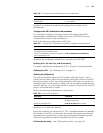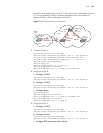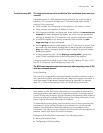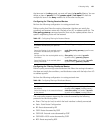
IP Routing Policy 151
Troubleshooting BGP The neighborhood cannot be established (the established state cannot be
entered).
The establishment of a BGP neighborhood requires that the router be able to
establish a TCP connection through port 179 and exchanges open packets
correctly. Do the following:
■ Check whether the configuration of the neighbor's AS number is correct.
■ Check whether the neighbor's IP address is correct.
■ If the loopback interface is not being used, check whether the connect-source
loopback has been configured. By default, the router uses the optimal local
interface to establish the TCP connection, not using the loopback interface.
■ If the EBGP neighbor is not directly connected, check whether the peer
ebgp-max-hop has been configured.
■ Use the ping command to check whether the TCP connection is normal. Since
one router may have several interfaces able to reach the peer, the extended
ping -a ip-address command should be used to specify the source IP address
sending ping packet.
■ If the ping operation fails, use the display ip routing-table command to
check if there is available route in the routing table to the neighbor.
If the ping operation succeeds, check if there is an ACL denying TCP port 179. If
the ACL is configured, cancel the denying of port 179.
The BGP route cannot be advertised correctly after importing route of IGP
with the command network.
Do the following:
The route that is imported by a command network should be same as a route in
the current routing table, and should include a destination segment and mask. A
route that covers a large network segment cannot be imported. For example,
route 10.1.1.0/24 can be imported, while 10.0.0.0/8 may cause an error.
IP Routing Policy When a router distributes or receives routing information, it needs to implement
some policies to filter the routing information so it can receive or distribute the
routing information that meets only the specified condition. A routing protocol
such as RIP may need to import routing information discovered by other protocols
to enrich its routing knowledge. While importing the routing information, it must
import only the information that meets its conditions.
To implement the routing policy, you must define a set of rules by specifying the
characteristics of the routing information to be filtered. You can set the rules
based on such attributes as destination address and source address of the
information. The rules can be set in advance and then used in the routing policy to
advertise, receive, and import the route information.
Configuring IP Routing Policy is described in the following sections:
■ Routing Information Filters
■ Configuring an IP Routing Policy


















